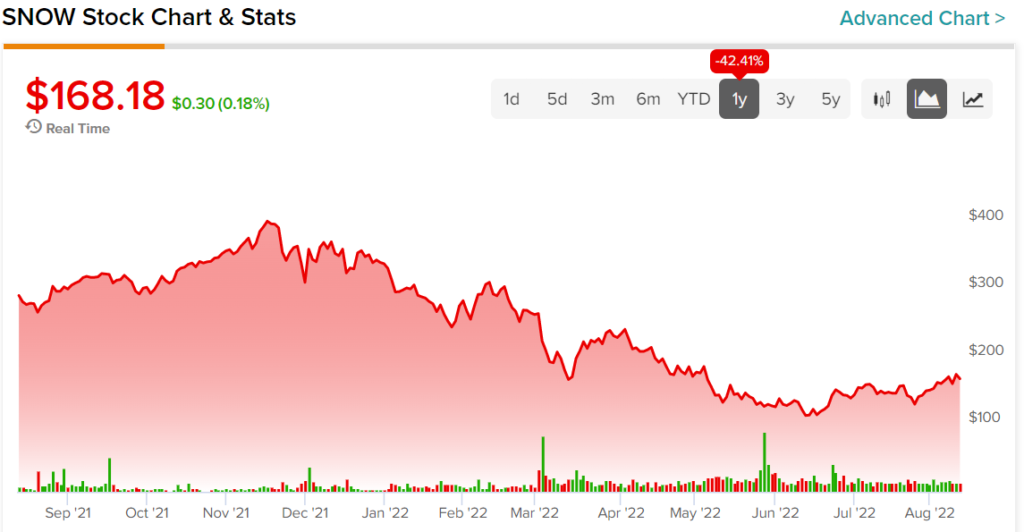Snowflake (SNOW) could potentially have an incredibly bumpy road ahead, given the firm’s usage-based revenue recognition model. Nevertheless, I think the long-term growth profile and secular tailwinds are more than enough reasons to give Snowflake the benefit of the doubt. Shares have been gaining considerable ground in recent weeks. Still, the stock is well off its peak of around $400 per share, leaving it ample upside potential.
At writing, the wildly-volatile data-cloud innovator is up around 50% from its bottom hit in June 2022. Indeed, investors have eased over rising interest rates and the implications of the next recession.

Although the share price has collapsed from its highs, the $57 billion big-data play remains quite expensive at 36 times sales, well above the industry average, just north of 10 times. With the ability to continue posting impressive growth through a recession without having to reinvest heavily, I think Snowflake is one of few technology stocks out there that’s actually worth a multiple north of 40 times sales.
I remain incredibly bullish on Snowflake stock as shares look to melt up again.
Economic Weakness Likely to Impact IT Spending
As we head into a recession or period of economic weakness, IT spending could take a bit of a hit. Undoubtedly, most layoffs, hiring freezes, and rescinded job offers have been concentrated within the tech sector. Even the resilient big-tech firms (think the FAANG companies) have been more cautious with their hiring practices going into the second half of 2022.
Undoubtedly, the tech-focused weakness does not bode well for the broader batch, especially firms like Snowflake that may not be seen as essential to day-to-day operations. Further, the usage-based revenue recognition model will not do the firm’s coming quarters any favors.
As I noted in prior pieces, the usage-based model could go from volatility exacerbator to revenue accelerator. No subscriptions or lock-in makes firms more willing to try and discover what Snowflake’s cloud-based offering can provide.
If they like what they see, they don’t need to be “locked in” to stay aboard. In this regard, Snowflake has a moat surrounding its user base. It’s not in the form of “contractual obligations” but in the customers’ willingness to stick around.
The usage-based model has its cons, though, and as the economy grinds to a slowdown, these cons will heavily outweigh the pros.
Charging customers based on usage could make revenue growth look incredibly ugly once firms begin to cut back. As IT budgets contract, Snowflake’s revenue growth deceleration could easily give the impression that the firm’s best days are behind it.
Though the usage-based model is bound to induce volatility, it could pay off with a “snowballing” effect down the road once the next bull market roars and the magnitude of data swell at an exponential rate.
In short, volatility works both ways.
For Snowflake, more client data means more usage of storage and analytics solutions, which, in turn, means more sales. As Snowflake continues adding to its tech arsenal, use could rebound sharply.
Ahead of a downturn, it’ll work against Snowflake. However, come the next expansionary cycle (markets may soon begin to look past the 2023 economic storm clouds), Snowflake could find itself storming out of the gate stronger than ever.
Snowflake Likely to Come Out of a Recession Stronger
As the old saying goes, “what doesn’t kill you makes you stronger.” Truly wonderful businesses treat a recession not as a setback but as an opportunity to gain ground on rivals and strengthen their market position. Snowflake has a nice headstart in its nascent industry, and it’s well-equipped to widen the gap as firms recognize the phenomenal growth from platforms and tools that unlock the full potential of data sets.
Data is a commodity and a very precious one in the digital age. I view Snowflake as akin to a commodity player in the midstream and downstream. Indeed, refining, moving (or sharing), and storing data is where Snowflake shines.
Snowflake faces stiff competition from the big tech in the realm of data warehousing and analytics. Further, up-and-comer Databricks is hungry to take a sizeable bite out of the data cloud. Snowflake has stayed on its toes, and it’s likely to continue doing so as times get tougher.
Snowflake will be busy improving as the economic tides go out, all while the digital transformation secular trend encourages firms to migrate their troves of data to the cloud.
What is the Target Price for Snowflake Stock?
Turning to Wall Street, Snowflake has a Moderate Buy consensus rating based on 21 Buys, six Holds, and two Sells assigned in the past three months. The average Snowflake price target of $184.80 implies 9.8% upside potential. Analyst price targets range from a low of $120.00 per share to a high of $295.00 per share.

Takeaway – Snowflake Stock is Not Like Other Tech Stocks
Snowflake isn’t cheap at around 40 times sales, with a lack of profits to show today or anytime in the near future. However, the secular tailwinds at the firm’s back are so powerful that I think Snowflake doesn’t deserve to be grouped with the rest of its fallen speculative tech peers. The company’s days of high double-digit growth are far from over. While a recession could weigh over coming quarters, the long-term trend is still a friend of the firm.









